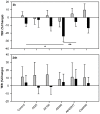Barrier disrupting effects of alternaria alternata extract on bronchial epithelium from asthmatic donors
- PMID: 24009658
- PMCID: PMC3751915
- DOI: 10.1371/journal.pone.0071278
Barrier disrupting effects of alternaria alternata extract on bronchial epithelium from asthmatic donors
Abstract
Sensitization and exposure to the allergenic fungus Alternaria alternata has been associated with increased risk of asthma and asthma exacerbations. The first cells to encounter inhaled allergens are epithelial cells at the airway mucosal surface. Epithelial barrier function has previously been reported to be defective in asthma. This study investigated the contribution of proteases from Alternaria alternata on epithelial barrier function and inflammatory responses and compared responses of in vitro cultures of differentiated bronchial epithelial cells derived from severely asthmatic donors with those from non-asthmatic controls. Polarised 16HBE cells or air-liquid interface (ALI) bronchial epithelial cultures from non-asthmatic or severe asthmatic donors were challenged apically with extracts of Alternaria and changes in inflammatory cytokine release and transepithelial electrical resistance (TER) were measured. Protease activity in Alternaria extracts was characterised and the effect of selectively inhibiting protease activity on epithelial responses was examined using protease inhibitors and heat-treatment. In 16HBE cells, Alternaria extracts stimulated release of IL-8 and TNFα, with concomitant reduction in TER; these effects were prevented by heat-treatment of the extracts. Examination of the effects of protease inhibitors suggested that serine proteases were the predominant class of proteases mediating these effects. ALI cultures from asthmatic donors exhibited a reduced IL-8 response to Alternaria relative to those from healthy controls, while neither responded with increased thymic stromal lymphopoietin (TSLP) release. Only cultures from asthmatic donors were susceptible to the barrier-weakening effects of Alternaria. Therefore, the bronchial epithelium of severely asthmatic individuals may be more susceptible to the deleterious effects of Alternaria.
Conflict of interest statement
Figures





Similar articles
-
T cell-mediated induction of thymic stromal lymphopoietin in differentiated human primary bronchial epithelial cells.Clin Exp Allergy. 2014 Jul;44(7):953-64. doi: 10.1111/cea.12330. Clin Exp Allergy. 2014. PMID: 24773145
-
ATP release and Ca2+ signalling by human bronchial epithelial cells following Alternaria aeroallergen exposure.J Physiol. 2013 Sep 15;591(18):4595-609. doi: 10.1113/jphysiol.2013.254649. Epub 2013 Jul 15. J Physiol. 2013. PMID: 23858006 Free PMC article.
-
Allergens produce serine proteases-dependent distinct release of metabolite DAMPs in human bronchial epithelial cells.Clin Exp Allergy. 2018 Feb;48(2):156-166. doi: 10.1111/cea.13071. Epub 2017 Dec 28. Clin Exp Allergy. 2018. PMID: 29210131
-
Bronchial epithelium in children: a key player in asthma.Eur Respir Rev. 2016 Jun;25(140):158-69. doi: 10.1183/16000617.0101-2015. Eur Respir Rev. 2016. PMID: 27246593 Free PMC article. Review.
-
Alternaria alternata allergens: Markers of exposure, phylogeny and risk of fungi-induced respiratory allergy.Environ Int. 2016 Apr-May;89-90:71-80. doi: 10.1016/j.envint.2016.01.003. Epub 2016 Jan 28. Environ Int. 2016. PMID: 26826364 Review.
Cited by
-
Purified Native and Recombinant Major Alternaria alternata Allergen (Alt a 1) Induces Allergic Asthma in the Murine Model.J Fungi (Basel). 2021 Oct 24;7(11):896. doi: 10.3390/jof7110896. J Fungi (Basel). 2021. PMID: 34829186 Free PMC article.
-
Epithelial barrier function: at the front line of asthma immunology and allergic airway inflammation.J Allergy Clin Immunol. 2014 Sep;134(3):509-20. doi: 10.1016/j.jaci.2014.05.049. Epub 2014 Jul 29. J Allergy Clin Immunol. 2014. PMID: 25085341 Free PMC article. Review.
-
Epithelial Barrier Dysfunction in Chronic Respiratory Diseases.Front Physiol. 2021 Jun 24;12:691227. doi: 10.3389/fphys.2021.691227. eCollection 2021. Front Physiol. 2021. PMID: 34248677 Free PMC article. Review.
-
Allergenic proteases cleave the chemokine CX3CL1 directly from the surface of airway epithelium and augment the effect of rhinovirus.Mucosal Immunol. 2018 Mar;11(2):404-414. doi: 10.1038/mi.2017.63. Epub 2017 Jul 5. Mucosal Immunol. 2018. PMID: 28677664
-
Kids, Difficult Asthma and Fungus.J Fungi (Basel). 2020 Apr 27;6(2):55. doi: 10.3390/jof6020055. J Fungi (Basel). 2020. PMID: 32349347 Free PMC article. Review.
References
-
- Cookson W (2004) The immunogenetics of asthma and eczema: a new focus on the epithelium. Nat Rev Immunol 4: 978–988. - PubMed
-
- Bals R, Hiemstra PS (2004) Innate immunity in the lung: how epithelial cells fight against respiratory pathogens. Eur Respir J 23: 327–333. - PubMed
-
- Knight DA, Holgate ST (2003) The airway epithelium: structural and functional properties in health and disease. Respirology 8: 432–446. - PubMed
-
- Xiao C, Puddicombe SM, Field S, Haywood J, Broughton-Head V, et al. (2011) Defective epithelial barrier function in asthma. J Allergy Clin Immunol 128: 549–556. - PubMed
-
- Denning DW, O'Driscoll BR, Hogaboam CM, Bowyer P, Niven RM (2006) The link between fungi and severe asthma: a summary of the evidence. Eur Respir J 27: 615–626. - PubMed
Publication types
MeSH terms
Substances
Grants and funding
LinkOut - more resources
Full Text Sources
Other Literature Sources
Medical

